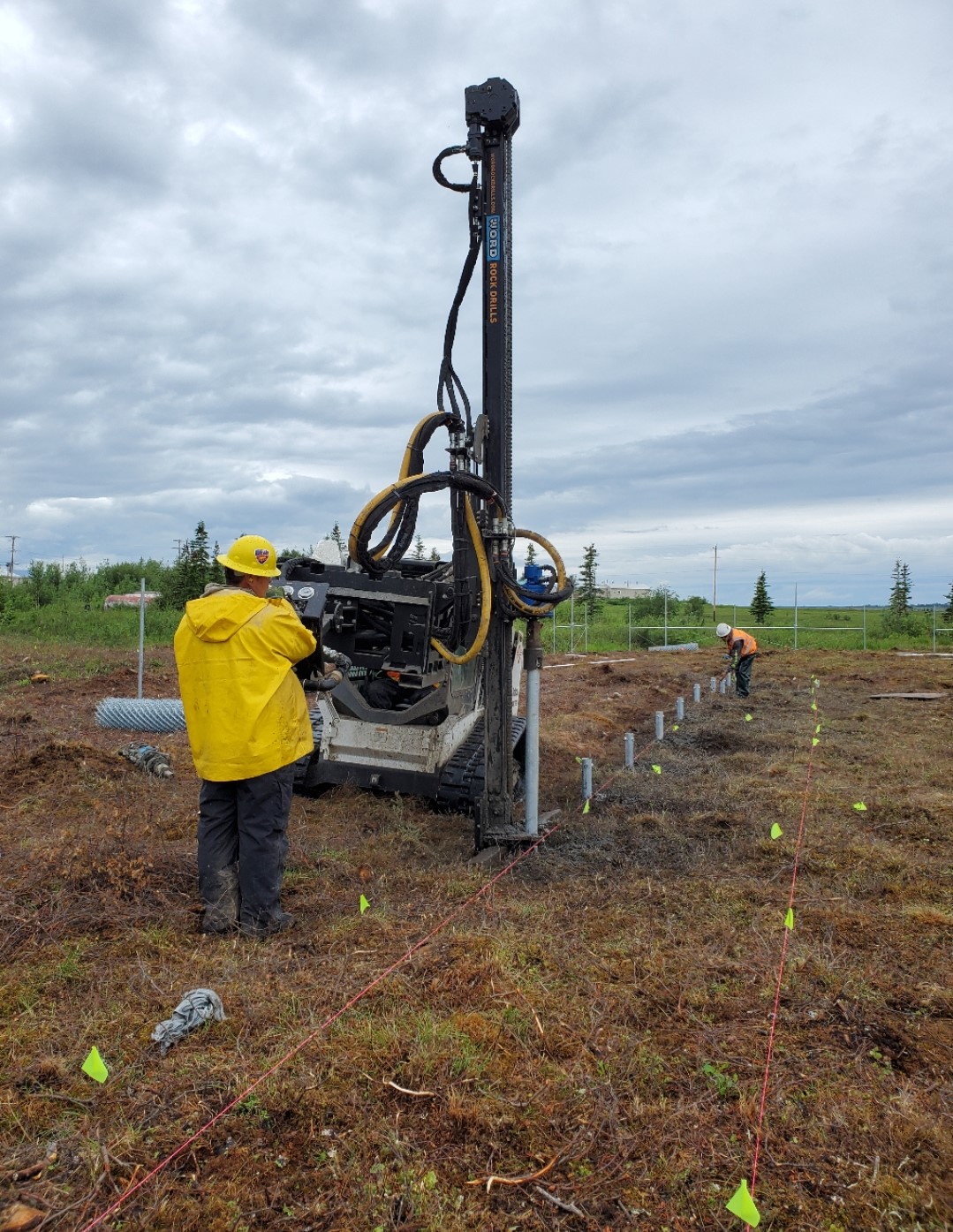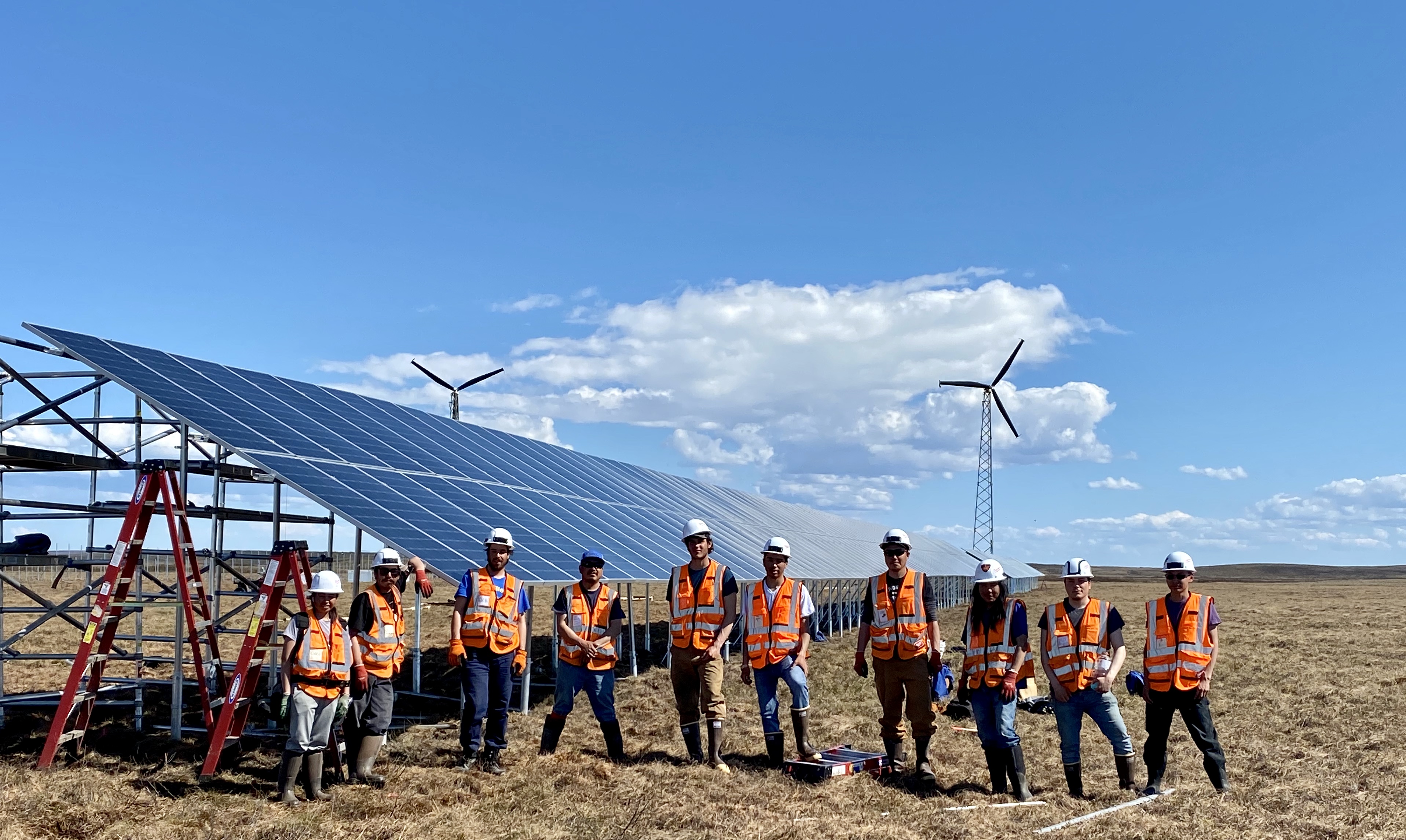Bringing my first solar PV project on-line for my grandfather
For decades, solar energy was discounted in Alaska. However, steep decline in solar photovoltaic (PV) prices and improved performance of batteries to store excess solar production has led to a mini-boom in recent solar PV deployments in Alaska. Ed Bifelt, founder of Alaska Native Renewable Industries, has been leading the charge for bringing the largest solar PV projects in the state to rural and remote microgrids. This is an excerpt from his chapter in the forthcoming University of Alaska Press book Alaska’s Energy Innovators.
By Ed Bifelt
November 15, 2024

Edwin Bifelt receiving the NCAIED Native American 40 under 40 award, March 2024.
The long dark nights of winter in Alaska and the endless days of summer when the sun never sets had persuaded many so-called experts that solar energy was just too difficult in Alaska. This was conventional wisdom for a long time, especially given the lack of cost-effective batteries to store energy when there was too little or too much solar power generation. As ACEP and others have documented, the average annual solar resource in Alaska is equal to or even better than Germany, one of the global leaders in renewable energy deployment.
Electricity and solar energy were relatively foreign concepts to me initially. My decision to enter the solar business was somewhat impromptu, driven by a spark of inspiration late one night – August 31, 2017 – to be precise. It was the eve of moose hunting season in Huslia, the community along the Koyukuk River where I was raised. I became possessed by a newfound fascination with the solar industry's potential. From that point forward, I dedicated myself to not only understanding the intricacies of solar photovoltaic (PV) technologies but also actively participating in the renewable energy business sector in Alaska with my own company.
My path in the energy industry was somewhat unique. Growing up, I was exposed to entrepreneurship through my parents. My father owned and operated a big-game guiding service that he started in the late '90s and operated for over 15 years. Simultaneously, my mother established a grocery store in Huslia in the early 2000s, which she continues to own and operate to this day. They were both self-employed. As a result, my parents instilled in me a strong entrepreneurial spirit.
In my initial consulting business, I had the opportunity to work on a grant involving LED lighting retrofits in Huslia, which exposed me to the world of energy upgrades. This project was ultimately extended to other Alaskan communities, including Ruby, Holy Cross and Hughes. These ventures provided hands-on experience and, even more importantly, trickles of revenue for my budding startup, which I named Alaska Native Renewable Industries.
My first solar PV project
To further advance my knowledge in the energy sector, I took courses with Solar Energy International. The training included online courses and certifications, with a significant hands-on portion during April 2018 in Payonia, CO. Around this time a potential 120 kilowatt (kW) solar project surfaced in Hughes, Alaska, my mother’s hometown. I was determined to secure it despite my lack of prior solar installation experience. As I completed the LED retrofit projects, I continued to gain practical knowledge about the ins-and-outs of contracting, as well as rural community work. By late 2018, a contract to build the Hughes solar project became a reality, presenting both an opportunity and a challenge. As the sole operator of my business, I embraced the chance to tackle this ambitious project but knew that it wasn’t going to be easy.
September of that same year, my grandpa Alfred fell seriously ill with cancer. My family and I decided to bring him back to Hughes, where he would ultimately pass away a week later. As I visited him in his last days, I received an email from Tanana Chiefs Conference asking if I would like to run the Hughes solar project. I was unsure, and asked my grandpa his thoughts as I had regularly done over the past few decades. In his final moments, he encouraged me to seize the opportunity, emphasizing its significance in my career. His words were, “You gotta do it.”
Balancing grief and professional commitments, I dove into the Hughes solar project, a substantial undertaking for a solo operator like myself. My team and I commenced construction of the project in October 2018. The initial phase involved learning on the fly, particularly with the challenges posed by Alaska's permafrost. Installing light helical piles to secure the foundations for the solar arrays to the earth proved problematic. So, we had to adapt and learn as we progressed. With time, we adopted a procedure similar to roof construction, making the process more manageable. Local workers in Hughes played a fundamental role, contributing to the successful completion of the foundation, racking, and panel installation, all finished just before the first snowfall on October 26, 2018. Despite the tough circumstances, I couldn't help but feel that my late grandpa guided us through the initial project implementation.
In 2019, we returned to Hughes to complete the more sophisticated electrical portion of the project. This phase presented additional learning experiences, but with the support of local workers and a competent electrical administrator – David Attla at Subzero Electric – we completed the entirety of our scope of work in September 2019. The Hughes project marked a significant milestone, not only in my career path but also as a tribute to my grandfather's legacy. It also was a milestone for the emerging solar energy industry in Alaska, marking it as the largest solar PV project in rural Alaska up to that point in time.

A.N.R.I construction foreman Helium 'Una' Edwardsen operating the drilling unit on the Shungnak project, June 2021.
Taking stock of Alaska’s future needs with private capital
Achieving the status of an independent power producer (IPP) and asserting ownership over energy assets to supply power to utilities is undoubtedly my long-term goal. If met, this aspiration would represent a major personal achievement. It would also be a great win for our collective efforts throughout rural Alaska, where innovation on the financial end of project development has historically been quite limited.
It's really important to acknowledge the pivotal role of private capital in fostering innovation in the sustainable energy space. This is where my schooling came in and really shaped my strategy. Rather than solely relying upon government grants, I knew we had to also leverage private capital to create a sustainable enterprise in such a difficult entrepreneurial venture as building an independent solar energy company from scratch in the middle of Alaska.
Still, what’s equally important for a successful small business are the people involved. Our operations today include a dedicated team of employees. Many of these employees are either family or have become family.
Despite our accomplishments, it's essential to recognize the relatively small scale of the solar industry in Alaska, whether in rural or urban settings. We firmly believe in the untapped opportunities within the solar industry throughout the state, and we view it with optimism. Our company perceives it as a sector with vast potential. But we have to be realistic in planning our strategy for the future.
In truth, the solar industry is still in its nascent stages in Alaska and the prevailing model often involves federally or state-funded projects. Many of the projects we undertake are grant-funded, reflecting the commitment to advancing renewable energy solutions in Alaska. While the current scenario is promising with grant-funded projects, their scarcity is also evident. Currently, our company typically engages in one to three large-scale projects annually. This is way too limiting for not just us, but vendors and consumers alike throughout the rest of the state.
To increase Alaska’s solar PV project portfolio, it's important to explore new models for project execution. The IPP and associated power purchase agreement (PPA) model emerges as a promising direction for the renewable energy industry here in Alaska. Furthermore, we anticipate that both the state and the federal government will play pivotal roles in steering the industry towards new paradigms. A transition to innovative approaches for financing and novel installation practices is clearly essential for sustainable growth. This shift would require innovation and adaptation in the way projects are conceived and implemented.
Solar energy's growth potential globally has inspired me to explore other aspects in the solar supply chain, such as solar module assembly or manufacturing. This aligns with the vision of creating a more stable and reliable revenue stream. Manufacturing solar modules – especially at a large scale – can provide a consistent source of income, reducing dependence on inconsistent project-based revenue. And siting manufacturing facilities on tribal lands in California, Arizona, or New Mexico is an intriguing idea. Leveraging tribal lands for such projects not only aligns with the goal of supporting local communities like we’ve done in Alaska, but also opens up unique opportunities for collaboration and economic development with like-minded Native peoples throughout the country.

The A.N.R.I crew working on the first Kotzebue Electric Association Solar Project, June 2020.


